Kung Fu Master - Repair Log
I've had this one in my to-do pile for many months now, the pcb belongs to a fellow member of the Jamma+ site; Beaps.I felt really bad for having this one in the shop for so long, but after many dead-ends I'd finally made some progress.
The middle board originally seemed to have several intermittent soldering failures - cracked joints, burnt pins (from previous repairs perhaps?) and a few scratched traces - and the on-screen faults would come and go if the boards were tapped or flexed.
First off, I bypassed the burned pads with jumper wires..
And likewise the cut traces..
(Taped the wires down once the job was complete)
Thought that would be the end of it.. but what was previously an intermittent glitch had became a rather permanent problem. The more I worked on the board, the worse it seemed to get (..and hence returned to the pile many times, for months). :/
But last night I recognised the visual glitch as being similar to a problem I encountered while working on an unrelated FPGA project..
So the instinct led me to the bus multiplexers.. the: 74LS157 chips.
Swapped the first one out..
Like so..
But now the fault was more solid than before - not fixed, but stable - were on the right track I guess..
Looking around the board I found four more 74LS157's, and with the trusty ninja-finger technique..
if the pins of two of them were touched (without applying pressure), the pattern on the screen changed from, this:
To this:
To me this indicates floating-pins, or dead memory cells (depending on the chip at hand).
And sure enough, all the 157's were Fugitsu's - which are known to have their gold wires detach from the silicon over time.. (this is well documented in many repair logs)
This ether detaches a pin completely & makes it 'floating' (neither 0 or 1) - or (as with this board initially) would produce an intermittent fault - even though the pcb looks good - it will be affected by vibration / prodding.
So went round with a logic probe & mapped out the state of all the pins while it was running..
(z = tri-state)
It turned out 3 more 74LS157 chips were pretty Fek'ed..
Next, I piggy-backed some new chips on the back of the old & on powering up the pcb, the display was restored!! \o/ Yay!
Unfortunatly.. murphy's law struck!
While de-soldering the three ic's several pads & the connected tracks came away with the iron!
The heat wasn't even set that high!! Argh!! Ruined!! Noooooooooo..
(a proper Darth-Vader moment)
Gutted! a real deal breaker potentially, so to be thorough I mapped out where all the affected pads went to with a continuity tester & draw a diagram (you can't see the traces once you fit the chips back):
Decided to solder the three new chips straight into the PCB - because you can't solder the top side under a socket.
And patched her up with kynar wire:
Then by 2am.. *drum roll* ..... All in check!
Kung Fu Master was once again, restored to it's former glory.
And as they say...





















